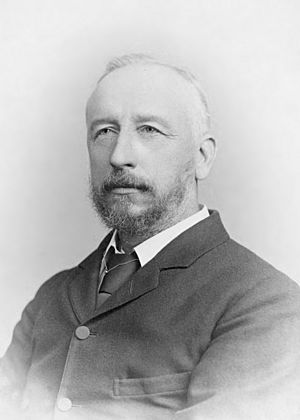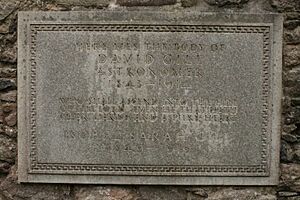David Gill (astronomer) facts for kids
Quick facts for kids
Sir
David Gill
|
|
|---|---|
 |
|
| Born | 12 June 1843 Aberdeen, Scotland
|
| Died | 24 January 1914 (aged 70) London, England
|
| Resting place | Aberdeen |
| Education | University of Aberdeen |
| Occupation | Astronomer |
| Title | FRS LL.D. CB KCB |
| Spouse(s) | Isobel Sarah Gill |
| Awards | Bruce Medal (1900) Valz Prize Gold Medal of the Royal Astronomical Society James Craig Watson Medal (1899) Commandeur de la Légion d'honneur Pour le Mérite |
Sir David Gill (born June 12, 1843 – died January 24, 1914) was a famous Scottish astronomer. He is best known for figuring out distances in space. He also took early photos of stars and helped map the Earth. Sir David Gill spent many years working in South Africa.
Contents
Life of a Star-Gazer
David Gill was born in Aberdeen, Scotland. His father was a watchmaker. David first went to school at Bellevue Academy and then Dollar Academy. He studied at Aberdeen University for two years. There, he learned from a famous scientist, James Clerk Maxwell.
After university, David joined his father's watchmaking business. But his real passion was astronomy. In 1863, he helped fix the university clock. He also set up a new telescope at the Cromwell Tower Observatory. This was his first step into the world of stars.
Early Adventures in Astronomy
David Gill soon sold his family business. He then helped set up a private observatory for Lord Lindsay. This observatory was in Dunecht, Scotland.
In 1874, David went on an exciting trip to Mauritius. He wanted to watch the planet Venus pass in front of the Sun. This event, called a transit of Venus, helps measure distances in space.
Three years later, he traveled to Ascension Island. His goal was to observe Mars when it was very close to Earth. By carefully watching Mars, he could calculate its distance from us.
Leading the Cape Observatory
While working on these big calculations, David Gill got an important job offer. He was asked to lead the Cape Observatory in South Africa. He spent 27 years there, from 1879 to 1906. He completely updated the observatory. He turned it into a top-notch place for studying the sky.
Gill was very careful in his observations. He knew how to get the best results from his tools. He used a special telescope called a heliometer. With it, he measured the distance to the Sun. He also figured out how far away some of the closer stars were. His work was very accurate and important. He even hired another great astronomer, Robert T. A. Innes, to work with him.
Pioneering Astrophotography
David Gill was a leader in using photography to study space. This is called astrophotography. He took the first photo of the Great Comet of 1882. This was a huge step forward for astronomy.
He realized that new "dry plate" photography could be used. This method made it easier to take pictures of stars. It also helped measure their positions and brightness. This idea led to a massive project. He worked with Dutch astronomer Jacobus Kapteyn. They created a huge catalog of southern stars. It listed the brightness and position of about half a million stars. This work was published in three books called Cape Photographic Durchmusterung.
Gill also helped start the Carte du Ciel project. This was a big international effort. Its goal was to map the entire sky using photographs.
Mapping the Earth
Sir David Gill was also interested in mapping the Earth. He started a project to measure a long line on Earth. This line stretched from South Africa all the way to Norway. It followed the 30th meridian east. This became the longest measured line on Earth at the time. This type of mapping is called a geodetic survey.
His focus on exact measurements led him to join the International Committee for Weights and Measures. He was a member from 1907 to 1914. He believed that measurements should be based on basic physics. He thought this was better than using old, physical standards like a metal rod.
Later Life and Legacy
David Gill married Isobel Black in 1870. She even joined him on his trip to Ascension Island to observe Mars.
When he retired in 1906, the couple moved to London. David Gill served as president of the Royal Astronomical Society from 1909 to 1911. He passed away in 1914. He was buried with his wife in St Machar's Cathedral in Aberdeen.
Awards and Recognition
Sir David Gill received many honors for his work:
- He became a Fellow of the Royal Society in 1883.
- He was made a Knight Commander of the Order of the Bath in 1900. This meant he was given the title "Sir."
- He was president of the Royal Astronomical Society from 1909 to 1911.
- He was a member of the Royal Swedish Academy of Sciences.
Lectures and Medals
In 1909, he gave the famous Royal Institution Christmas Lectures. His talks were about "Astronomy, Old and New."
He also won several important awards:
- Valz Prize (1879)
- Gold Medal of the Royal Astronomical Society (1882 and 1908)
- James Craig Watson Medal (1899)
- Bruce Medal (1900)
Named After Him
Two craters in space are named in his honor:
- Gill (lunar crater) on the Moon
- Gill (Martian crater) on Mars



